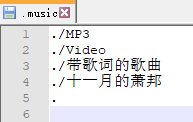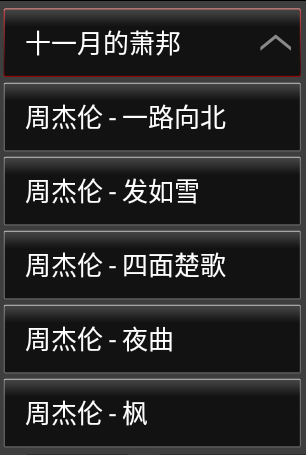DW公版音乐解析
一.代码位置
二.效果图

三.流程
3.1 开机底层服务自动扫描硬盘
TWService扫描 当机器的硬盘挂载完成后,就可以进行一些指定目录的扫描,Intent.ACTION_MEDIA_MOUNTED是外接设备就绪/插入的广播提示。
if(new File("/mnt/sdcard").canRead()) sendMedia(Intent.ACTION_MEDIA_MOUNTED, "file:///mnt/sdcard");
if(new File("/storage/extsd0").canRead()) sendMedia(Intent.ACTION_MEDIA_MOUNTED, "file:///storage/extsd0");
if(new File("/storage/extsd1").canRead()) sendMedia(Intent.ACTION_MEDIA_MOUNTED, "file:///storage/extsd1");
if(new File("/storage/usb0").canRead()) sendMedia(Intent.ACTION_MEDIA_MOUNTED, "file:///storage/usb0");
if(new File("/storage/usb1").canRead()) sendMedia(Intent.ACTION_MEDIA_MOUNTED, "file:///storage/usb1");
if(new File("/storage/usb2").canRead()) sendMedia(Intent.ACTION_MEDIA_MOUNTED, "file:///storage/usb2");
if (intent.getAction().equals(Intent.ACTION_MEDIA_MOUNTED)) {
String path = intent.getData().getPath();
...
new MediaScan().scanMedia(path);MediaScan
public class MediaScan {
private final ArrayList<String> video = new ArrayList<String>();
private final ArrayList<String> music = new ArrayList<String>();
private void scanPath(String volume, String path) {
File file = new File(volume + "/" + path);
if (file.isDirectory()) {
if (!new File(file, ".nomedia").exists()) {
File[] files = file.listFiles();
if(files != null) {
boolean isVideo = false;
boolean isMusic = false;
for (File f : files) {
if (f.canRead()) {
String n = f.getName().toUpperCase(Locale.ENGLISH);
if (!n.startsWith(".")) {
if (f.isDirectory()) {
if(!(n.startsWith("PROGRAM") ||
n.startsWith("SYSTEM") ||
n.startsWith("IGO") ||
n.equals("SYGIC") ||
n.equals("AURA") ||
n.equals("PAPAGO") ||
n.equals("TOMTOM") ||
n.equals("$RECYCLE.BIN") ||
n.equals("WINDOWS") ||
n.equals("BOOT") ||
n.equals("LOST.DIR") ||
n.equals("DCIM") ||
n.contains("NAVI"))) {
scanPath(volume, path + "/" + f.getName());
}
} else {
if (!isVideo) {
if (n.endsWith(".AVI") ||
n.endsWith(".ASF") ||
n.endsWith(".WMV") ||
n.endsWith(".M2T") ||
n.endsWith(".MTS") ||
n.endsWith(".TS") ||
n.endsWith(".MPG") ||
n.endsWith(".M2P") ||
n.endsWith(".MP4") ||
n.endsWith(".FLV") ||
n.endsWith(".SWF") ||
n.endsWith(".VOB") ||
n.endsWith(".MKV") ||
n.endsWith(".DIVX") ||
n.endsWith(".XVID") ||
n.endsWith(".MOV") ||
n.endsWith(".RMVB") ||
n.endsWith(".RV") ||
n.endsWith(".3GP") ||
n.endsWith(".PMP") ||
n.endsWith(".TP") ||
n.endsWith(".TRP") ||
n.endsWith(".RM") ||
n.endsWith(".WEBM") ||
n.endsWith(".M2TS") ||
n.endsWith(".SSIF") ||
n.endsWith(".MPEG") ||
n.endsWith(".MPE") ||
n.endsWith(".M3U8") ||
n.endsWith(".M4V") ||
n.endsWith(".3G2") ||
n.endsWith(".F4V") ||
n.endsWith(".3GPP")) {
isVideo = true;
}
}
if(!isMusic) {
if (n.endsWith(".MP3") ||
n.endsWith(".WMA") ||
n.endsWith(".AAC") ||
n.endsWith(".OGG") ||
n.endsWith(".PCM") ||
n.endsWith(".M4A") ||
n.endsWith(".AC3") ||
n.endsWith(".EC3") ||
n.endsWith(".DTSHD") ||
n.endsWith(".MKA") ||
n.endsWith(".RA") ||
n.endsWith(".WAV") ||
n.endsWith(".CD") ||
n.endsWith(".AMR") ||
n.endsWith(".MP2") ||
n.endsWith(".APE") ||
n.endsWith(".DTS") ||
n.endsWith(".FLAC") ||
n.endsWith(".MIDI") ||
n.endsWith(".MID") ||
n.endsWith(".MPC") ||
n.endsWith(".TTA") ||
n.endsWith(".ASX") ||
n.endsWith(".AIFF") ||
n.endsWith(".AU")) {
isMusic = true;
}
}
}
}
}
}
if (isVideo) {
video.add(path);
}
if (isMusic) {
Log.i("md", "增加路径 "+path);
music.add(path);
}
}
}
}
}
public void scanMedia(String volume) {
Log.i("md", "scanMedia " + volume);
String path = null;
video.clear();
music.clear();
try {
scanPath(volume, ".");
if(volume.startsWith("/storage/usb") || volume.startsWith("/storage/extsd")) {
path = "/data/tw/" + volume.substring(9);
} else {
path = volume + "/DCIM";
}
new File(path).mkdir();
FileUtils.setPermissions(path, 0755, -1, -1);
} catch (Exception e) {
}
try {
BufferedWriter bw = null;
try {
bw = new BufferedWriter(new FileWriter(path + "/.video"));
for (String v : video) {
bw.write(v);
bw.write('\n');
}
bw.flush();
} catch (Exception e) {
new File(path + "/.video").delete();
} finally {
if(bw != null) {
bw.close();
bw = null;
}
}
FileUtils.setPermissions(path + "/.video", 0666, -1, -1);
} catch (Exception e) {
}
video.clear();
try {
BufferedWriter bw = null;
try {
bw = new BufferedWriter(new FileWriter(path + "/.music"));
for (String v : music) {
bw.write(v);
bw.write('\n');
}
bw.flush();
} catch (Exception e) {
new File(path + "/.music").delete();
} finally {
if(bw != null) {
bw.close();
bw = null;
}
}
FileUtils.setPermissions(path + "/.music", 0666, -1, -1);
} catch (Exception e) {
}
music.clear();
}
}最终生成的文件是对应音乐视频文件的.Music文件

文件在对应data/tw/对应设备目录,我的设备是usb0

3.2 音乐启动时加载资源目录
MusicActivity启动时候对底层服务生产的.Music文件进行读取
private void initRecord() {
...
mUSBRecord = new Record("USB", 2, 0);
File[] fileUSB = new File("/storage").listFiles(new FileFilter() {
@Override
public boolean accept(File f) {
String n = f.getName();
if(f.canRead() && f.isDirectory() && n.startsWith("usb")) {
return true;
}
return false;
}
});
if(fileUSB != null) {
for(File f : fileUSB) {
addRecordUSB(f.getAbsolutePath());
}
}
...
}有的话进addRecordUSB(路径),新建一个Record实例对象,通过loadvolume方法扫描后添加到USB的record集合,
private void addRecordUSB(String path) {
...
Record r = new Record(path, 2, 0);
loadVolume(r, path);
mUSBRecordArrayList.add(r);
...
}Record中有保存如下信息
...
String mName //打开某个目录时,记录的目录名称
int mLevel; //列表的打开关闭状态 0:显示列表目录状态 1:点击了某个列表后显示“列表+文件目录”的状态
LName[] mLName; //目录名 目录路径集合 最关键的东西
public int mCLength; //歌曲的数量
...通过loadVolume解析.music文件,拿到目录名字和目录路径
private void loadVolume(Record record, String volume) {
if ((record != null) && (volume != null)) {
try {
BufferedReader br = null;
try {
String xpath = null;
if(volume.startsWith("/storage/usb") || volume.startsWith("/storage/extsd")) {
xpath = "/data/tw/" + volume.substring(9);
} else {
xpath = volume + "/DCIM";
}
br = new BufferedReader(new FileReader(xpath + "/.music"));
String path = null;
ArrayList<LName> l = new ArrayList<LName>();
while((path = br.readLine()) != null) {
File f = new File(volume + "/" + path);
if (f.canRead() && f.isDirectory()) {
String n = f.getName();
String p = f.getAbsolutePath();
if(n.equals(".")) {
String p2 = p.substring(0, p.lastIndexOf("/"));
String p3 = p2.substring(p2.lastIndexOf("/") + 1);
l.add(new LName(p3, p));
} else {
l.add(new LName(n, p));
}
}
}
record.setLength(l.size());
for(LName n : l) {
record.add(n);
Log.i("md", n.mName+" "+n.mPath+" ");
}
l.clear();
} catch (Exception e) {
} finally {
if(br != null) {
br.close();
br = null;
}
}
} catch (Exception e) {
}
}
}打印的地方是最终解析出来的文件名+路径

这些都存在于mSDRecordArrayList中,多个外接设备就集合中就有多个Record
3.3 U盘热拔插加载列表逻辑
当设置在运行状态进行U盘热拔插时,底层服务会受到Intent.ACTION_MEDIA_MOUNTED和Intent.ACTION_MEDIA_UNMOUNTED,直接会通知应用。
拔
if (intent.getAction().equals(Intent.ACTION_MEDIA_UNMOUNTED)) {
String path = intent.getData().getPath();
if(path.equals("/mnt/sdcard")) {
mTW.write(0x9e1f, 3, 0);
} else if(path.startsWith("/storage/extsd")) {
mTW.write(0x9e1f, 1, 0, path.substring(9));
} else if(path.startsWith("/storage/usb")) {
mTW.write(0x9e1f, 2, 0, path.substring(9));
}
}应用中接收处理
case TWMusic.RETURN_MOUNT: {//u盘拔插通知
String volume = null;
switch(msg.arg1) {
case 1:
volume = "/storage/" + msg.obj;
if(msg.arg2 == 0) {
removeRecordSD(volume);
} else {
addRecordSD(volume);
}
showTRText(R.id.sd);
break;
case 2:
volume = "/storage/" + msg.obj;
if(msg.arg2 == 0) {
removeRecordUSB(volume);
} else {
addRecordUSB(volume);
}
showTRText(R.id.usb);
break;
case 3:
volume = "/mnt/sdcard/iNand";
if(msg.arg2 == 0) {
mMediaRecord.clearRecord();
} else {
loadVolume(mMediaRecord, volume);
}
break;
}应用会根据当前拔出的设备名称,对对应的Record集合进行移除,然后更新列表
插 U盘插入的话,底层服务就会继续走自动扫描逻辑,然后扫描完成后通知应用更新读取。
3.4音乐列表显示与点击
每个音乐都至少有一个音乐列表目录,以TW2为例
mPlaylistRecord
mSDRecordArrayList[position]
mUSBRecordArrayList[position]
mMediaRecord点击对应外接设备类型,列表就会去加载对应的Record,我们程序里是用mCList拉皮条
adapter
private class MyListAdapter extends BaseAdapter {
...
@Override
public int getCount() {
if(mCList == null) {
return 0;
} else if(mCList.mLevel == 0) { //显示的是目录列表状态 如附图1
return mCList.mCLength;
} else {
return mCList.mCLength + 1; //显示的是“目录+目录文件”状态,如附图2,音乐多了个目录item,所以长度要+1
}
}
...
private void bindView(View v, int position, ViewGroup parent) {
ViewHolder vh = (ViewHolder) v.getTag();
String name, path;
if(mCList.mLevel == 0) { //显示的是目录列表状态时候,name和path老老实实加载
name = mCList.mLName[position].mName;
path = mCList.mLName[position].mPath;
} else if(position == 0) {//显示的是“目录+目录文件”状态 第一个item显示的是保存的打开目录名称
name = mCList.mName;
path = null;
} else {//显示的是“目录+目录文件”状态 name和path的position-1加载
name = mCList.mLName[position - 1].mName;
path = mCList.mLName[position - 1].mPath;
}
vh.line.setText(name);
...
}
private Context mContext;
}附图1:

附图2:

点击列表时发生了什么
mList.setOnItemClickListener(new OnItemClickListener() {
@Override
public void onItemClick(AdapterView<?> parent, View view,
int position, long id) {
if((mCList.mLevel != 0) && (position == 0)){//附图2状态 点击了第一个item,就是目录名称 ,收回到全目录列表状态
mCList = mCList.mPrev; //加载上一个Record列表
} else {
if(mCList.mLevel != 0) {
position--;
}
if((mCList.mLevel == 0) && (mCList.mIndex != 0)) {//附图1状态 点击了目录列表 摊开目录的歌曲
Record r = mCList.getNext(position);
if(r == null) {
r = new Record(mCList.mLName[position].mName, position, mCList.mLevel + 1, mCList);
mTW.loadFile(r, mCList.mLName[position].mPath);
}
mCList.setNext(r);
mCList = r;
} else {//附图2状态 点击了歌曲 播放
mTW.mCurrentIndex = position;
mTW.mCurrentAPath = mCList.mLName[position].mPath;
String path = mTW.mCurrentAPath.substring(0, mTW.mCurrentAPath.lastIndexOf("/"));
if((path != null) && !path.equals(mTW.mCurrentPath)) {
if(mCList.mLevel == 1) {
mTW.mPlaylistRecord.copyLName(mCList);
}
}
mTW.toRPlaylist(position);
mTW.mCurrentPath = path;
current(0, false);
}
}
mAdapter.notifyDataSetChanged();
}
});本文参与 腾讯云自媒体同步曝光计划,分享自微信公众号。
原始发表:2021-07-10,如有侵权请联系 cloudcommunity@tencent.com 删除
评论
登录后参与评论
推荐阅读
目录
